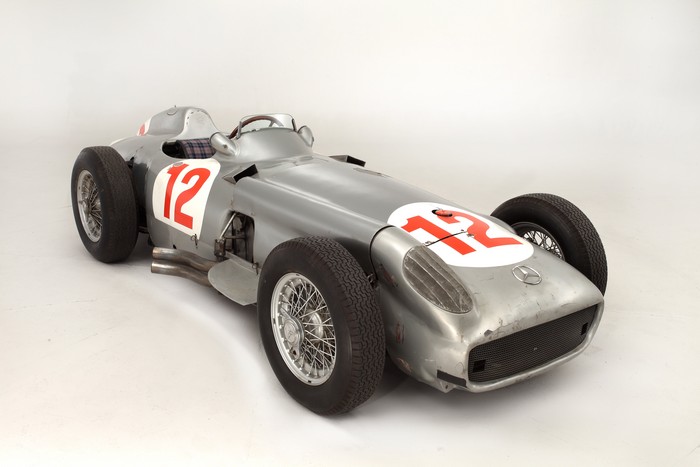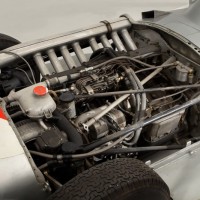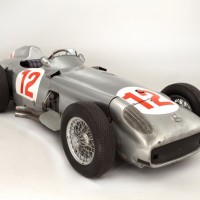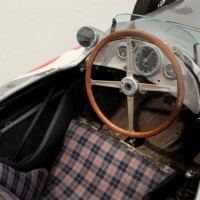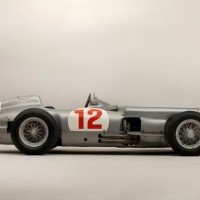With the approach of the new Formula 1 that was due to begin with the 1954 season, Daimler-Benz announced that they would be represented by an entirely new team of Mercedes-Benz racing cars. When these entirely new W-196 cars emerged at Reims, fans recoiled in astonishment. These sleek new silver rocket ships were futuristically alien machines from Mars. Juan Fangio and Karl Kling immediately qualified first and second, then finished 1-2 in this their debut race.
Over the fleeting 14 months that followed — completing the 1954 season and on through 1955 — the Mercedes Benz A W-196 single-seater contested 12 World Championship qualifying Grands Prix. They won nine of them, confirmed Fangio’s 194 Driver’s World Championship, and then carried him to a second consecutive Driver’s title in 1955. Through that second season of the W-196’s meteorically brief career, the Daimler-Benz factory team had also campaigned its related 300SLR sports-racing cars. They proved fantastically unbeatable, winning every Sports Car World Championship race entered except Le Mans, from which the team was withdrawn when running 1-2.
On October 16, 1955, Stirling Moss and Peter Collins won the Targa Florio in Sicily to add the Sports Car title to Fangio’s Formula One Driver’s crown. With both World Championships won and total road-racing domination re-established, Mercedes-Benz had nothing left to prove.
SCM Analysis
Detailing
| Vehicle: | 1954 Mercedes-Benz W-196 Formula One Racer |
| Number Produced: | 14 |
| Original List Price: | N/A |
| SCM Valuation: | $25,000,000 to $33,000,00 |
| Chassis Number Location: | Front upper frame crossmember |
| Engine Number Location: | Front top behind crank dampener |
| Club Info: | Unobtanium Owners Association |
| Alternatives: | 1956 Maserati 250F, Lancia D-50, Ferrari 625 F1 |
This car, Lot 320, sold for $29,496,308, including buyer’s premium but not including European VAT, at Bonhams’ auction in Chichester, U.K., on July 12, 2013.
I’m going to open this discussion with a disclaimer: I am not qualified to address the issue of the value that this car returned — not that this is going to stop me, of course. I well understand historic racing cars and the market for them, and this is unquestionably one of the greatest of racing cars, but that market does not address what happened here. This car sold as collectible fine art that happens to be an automobile — a 1,600-pound mechanical Rembrandt, if you will. Understanding this sale requires considering both the collector automobile and the fine-art markets in today’s world.
Miles Collier did a wonderful job of explaining the W-196 and why it is both important and collectible in the July edition of this magazine (“Collecting Thoughts,” p. 36), so I will summarize rather than rehash his excellent work.
It has been said that the Mercedes W-196 was the car that Mercedes built to demonstrate that Germany should not have lost the war — or at least that it wasn’t Mercedes’ fault that they did. The W-196 hit the automobile racing world like a blitzkrieg — an overwhelming display of technical, financial, and organizational prowess that simply changed the rules of the game for as long as Mercedes chose to remain in it. In many ways, Mercedes changed them forever.
A giant leap in technology
I have had occasion to spend considerable time around various Mercedes W-196 cars, and the technical sophistication and engineering quality are simply staggering.
The straight-8 engine is effectively two 4-cylinder units joined with the power takeoff in the middle, which keeps the crank and camshafts from getting too long. The crankshaft is a built-up Hirth unit running in roller bearings. On the 2.5-liter GP W-196, the cylinder blocks are welded up from machined steel plates, not cast units, which makes them both light and strong — but very difficult to actually build (the 3-liter SLR sports racers use cast blocks).
“Valve float” at high RPM was a serious problem with the spring technology available in the early 1950s, so Mercedes chose to implement a desmodromic system, in which the cams both open and close the valves.
This car used the world’s first automotive direct fuel injection. The litany of wonder goes on and on — from the inboard brake front suspension to the pumps mounted at the back of the transaxle. Save possibly the gauges, there are no components on the entire car that were not designed, engineered, and constructed specifically for the W-196.
There is no techno-geek anywhere worth his dirty fingernails who couldn’t spend hours happily contemplating any given cubic foot of the entire car. It’s that cool.
The car as fine art
Despite all the techno marvels, history and coolness, this W-196 is still an old racing car — even if arguably the ultimate one — and as such, its value should have been more constrained.
As a rule, open-wheel single-seat GP cars carry half to two-thirds the value of their sports-car equivalents, primarily because there are fewer things you can do with a GP car.
Going into the auction, there was broad consensus among those who are supposed to know — including Miles Collier and myself — that the car would sell somewhere in the $12 million to $15 million range. I at least will continue to argue that this was the appropriate value for the car as a racing automobile. The car was a tough sale (i.e. fully valued) at $9 million in 2000, and adjusting for inflation and a strong market would get you to the figure we had.
What we didn’t factor in was the art-market component.
The first thing for ordinary mortals to understand about the “big art” market is that it doesn’t follow any of the standard rules about value. Maybe an essential point is that it is not about value at all — at least not in the sense that most of us perceive the term.
An art market specialist once pointed out that no painting bought for more than $30 million has ever been resold for a profit, yet buyers have happily shelled out $87 million for a Rothko or $120 million for Munch’s “The Scream.” Obviously, different rules apply here; it’s as much about being able to have something that others want as about productive places to put your money.
Art is about desirability, exclusivity, and peer prestige — and knowing you have a collection nobody else can match. It’s a game the super-rich can and do play, and lately it looks like it has expanded to include the very top of the collector-car market.
Exclusivity is extremely important here, and Mercedes’ Silver Arrows easily top the list. To the best of my knowledge, Mercedes has never willingly parted with any of its pure racing cars (they did sell of a few W-194s, which were the 300SL prototypes). The handful of pre-World War II Silver Arrows that are in private hands escaped because they were moved to Eastern Europe to avoid Allied bombing and ended up forfeited behind the Iron Curtain before making it back West after its fall.
Today’s W-196 was originally loaned to the Beaulieu Museum, but a very poorly worded agreement left the window open, and the museum needed capital improvements. So they sold the car to a private party, and it was lost to Mercedes. It is extremely unlikely that Mercedes will ever allow this to happen again, so the available set of factory Silver Arrows can be counted on one hand, and the post-war subset is likely forever limited to just one: our subject car.
Price not a barrier
So the question on people’s minds as the bidding really got going was: “What is the art premium going to run to?” There was no shortage of bidders, including one of the previous owners who really, really wanted it back, but the bidding kept going. It is interesting to note that the seller was the government of Qatar (long story), so if the buyer was a European national, there was another 5% in EU import duties to be paid.
A friend of mine was sitting in the room close to the phones, and he noticed that the representative on the line with the winning bidder was speaking German, so this is probably the case. That means the real cost was just under $31 million. Not that it probably mattered much, though. This was one very determined buyer in a swarm of couldn’t-quite-get-theres.
As I stated when I opened the discussion, I’m not qualified to pass judgment on whether this car was well or poorly bought. It brought roughly 100% art premium over the core value, but it was the only chance for a very long time to have one, and the top 0.01% operate by rules I can only guess at.
By the time you read this, Monterey will have happened. There are a number of cars entered there that are expecting (depending on) a substantial fine-art premium to justify their reserves, so we will then know a lot more about the degree to which the market will accept this new premium and on which cars it will be bestowed.
For now — and in the circumstance of the ultimate Mercedes — I can only observe that the successful bidder was probably pleased and that the others were bitterly disappointed. ?
(Introductory description courtesy of Bonhams.)
